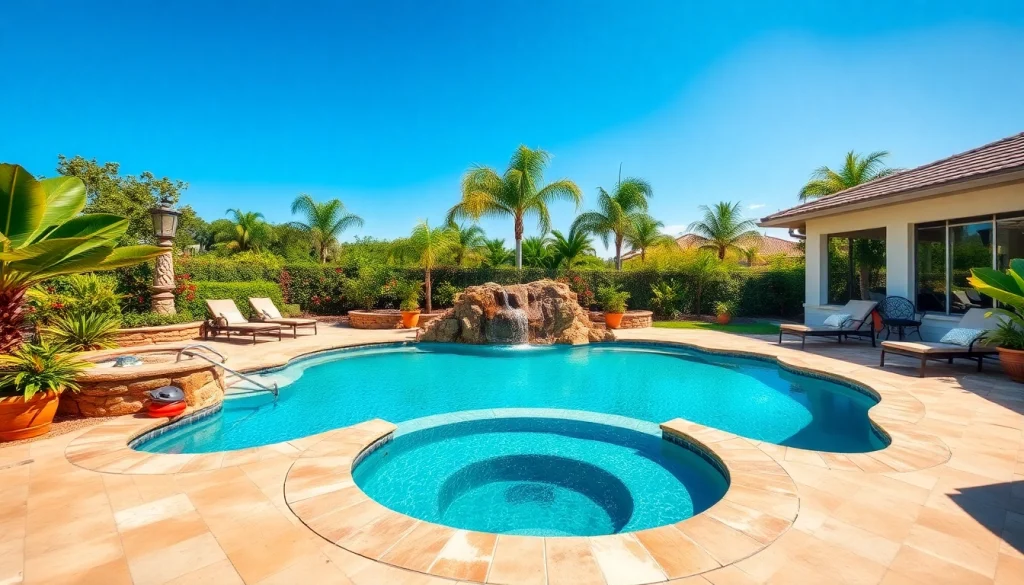Understanding the Basics of Pool Construction
Building your own pool can be an exciting but complex project that transforms your backyard into a personal oasis. From the original concept to the final installation, understanding the elements of pool construction is crucial. This guide offers comprehensive insights into how to build your own pool, ensuring you have all the information you need for a successful project.
Types of Pools: Above Ground vs. In-Ground
When considering a pool, the first decision you’ll need to make is whether to opt for an above-ground or in-ground pool. Each type has its own unique advantages and considerations.
- Above Ground Pools: Typically less expensive and quicker to install, above-ground pools are ideal for homeowners looking for a temporary or less permanent solution. They come in various sizes and shapes and are often easier to dismantle if necessary.
- In-Ground Pools: These provide a more permanent and aesthetically pleasing option. In-ground pools can be customized in terms of shape, size, and depth, and they generally offer a variety of materials such as fiberglass, vinyl, and concrete. However, they require a significant budget and time investment.
Key Elements for Building Your Own Pool
Regardless of the type chosen, several key elements must be considered during the pool construction process:
- Design: Determine the shape and size of your pool. Consider whether you want additional features such as a spa, waterfall, or a custom deck.
- Materials: Choose materials that complement your landscape. Common choices are concrete for durability, fiberglass for installation speed, and vinyl for lower costs.
- Equipment: Invest in quality equipment, including pumps, filters, and heaters, to maintain water quality and ensure a pleasant swimming experience.
Planning Your Pool’s Location and Design
Choosing the right location for your pool is essential to enhance its functionality and aesthetic value. Consider these factors:
- Sunlight Exposure: Position your pool in an area that receives ample sunlight for warm water and comfortable swimming temperatures.
- Accessibility: Ensure easy access to your pool from your home, patio, or deck. This enhances usability and safety, especially for kids.
- Landscaping: Plan for surrounding trees, plants, and patios. This not only impacts the beauty of the area but can also affect maintenance, safety, and availability of shade.
Essential Considerations Before You Build Your Own Pool
Before diving into construction, it’s vital to assess several considerations that can affect the overall project.
Budgeting for Your Pool Project
Establishing a budget is one of the first steps in your pool construction project. This should include not only the cost of materials and labor but also ongoing maintenance costs. Here are essential budget components to consider:
- Initial Costs: This includes excavation, lining, equipment, and landscaping. Obtain multiple quotes from contractors if hiring out.
- Ongoing Expenses: Factor in maintenance and utility costs, such as water put into the pool, electricity for pumps, and chemicals for upkeep.
- Contingency Fund: Set aside a percentage of your budget (typically 10-20%) for unforeseen expenses that might arise during the construction process.
Permits and Regulations to Consider
Before starting construction, it’s crucial to research local zoning laws and obtain any necessary permits. Here are some points to keep in mind:
- Permit Requirements: Most jurisdictions require a permit for pool installation. Check with your city or county building department for guidelines.
- Building Codes: Familiarize yourself with safety features mandated by local building codes, including fencing, pool alarms, and drain covers.
- Homeowners Associations (HOA): If you live in an area governed by an HOA, you may need to obtain approval for your pool design and location.
Choosing Materials for Longevity and Aesthetics
The materials you select will influence the longevity and overall look of your pool. Common options include:
- Concrete: Known for its durability and customization options, concrete pools can be shaped to fit any design but usually involve a higher upfront cost.
- Fiberglass: These pools come preformed and are quick to install. They require less maintenance, but design options are limited.
- Vinyl: A more budget-friendly option, vinyl liners can be easily replaced and provide a variety of design options, though they may not be as durable as concrete or fiberglass.
Step-by-Step Guide to Build Your Own Pool
The construction of a pool can be broken down into manageable steps, which simplifies the process and ensures nothing is overlooked.
Preparing the Site and Groundwork
The first step involves site preparation, which sets the stage for a successful pool installation. Important tasks include:
- Clearing the Area: Remove any obstacles such as trees, rocks, or old debris. This ensures you have a clean workspace for construction.
- Excavation: Dig out the area according to the design — precise measurements are crucial for ensuring the correct installation of the pool.
- Leveling: It’s essential to ensure the ground is level and compacted. An unlevel site can lead to structural issues.
Installing the Pool Frame and Liner
Once the site is prepared, it’s time to install the pool frame and liner. This involves several steps:
- Setting Up the Frame: If you’re building an above-ground pool, assemble the metal frame according to the manufacturer’s instructions. For in-ground pools, follow the specific requirements for the chosen material.
- Securing the Liner: If using a liner, ensure it is fitted securely. Proper alignment helps protect against leaks and damage.
- Backfilling: For in-ground pools, backfill around the walls and ensure the structure is secure.
Adding Water Features and Landscaping
Enhance your pool with water features and landscaping. These elements can create a stunning visual impact and contribute to the overall ambiance.
- Waterfalls and Fountains: Incorporate features such as waterfalls or bubblers for aesthetic appeal and additional water circulation.
- Decking and Patios: Construct surrounding decks or patios using materials like wood or pavers that match your pool’s style.
- Landscaping: Select plants that flourish in your climate while considering maintenance requirements, ensuring they complement the pool area.
Maintenance Tips After You Build Your Own Pool
Once your pool is complete, ongoing maintenance is necessary to keep it in pristine condition and ensure a safe swimming environment.
Regular Cleaning and Chemical Balancing
Maintaining water quality is vital for a safe swimming experience. Regular tasks include:
- Cleaning: Skim the surface daily for debris, brush the walls weekly, and vacuum the pool floor regularly.
- Testing Water Chemistry: Regularly test pH levels and adjust chemicals accordingly to keep water balanced. This includes managing chlorine levels, alkalinity, and calcium hardness.
- Filter Maintenance: Backwash or clean the filters monthly to ensure efficient functioning.
Winterization and Seasonal Care
Preparing your pool for seasonal changes is crucial, especially during winter:
- Winterizing Your Pool: Lower the water level and add appropriate chemicals to protect against freezing and algae growth.
- Covering the Pool: Use a sturdy cover that is fitted tightly to prevent debris accumulation.
- Spring Start-Up: When reopening, conduct thorough cleaning and chemical balancing to prepare for the swimming season.
Troubleshooting Common Pool Issues
Even well-maintained pools can encounter issues. Here are some common problems and their solutions:
- Cloudy Water: Often caused by poor filtration or imbalanced chemicals. Test and adjust water chemistry and ensure filtration systems are functioning correctly.
- Algae Growth: May occur due to insufficient sanitizer levels. Shock the pool as needed and brush surfaces to remove algae.
- Leaks: If you notice a decrease in water levels, inspect for leaks in hoses, fittings, or the liner.
Maximizing Enjoyment and Safety in Your Pool Area
Creating a safe and enjoyable environment is important for a successful pool experience, not just for you but for your family and guests as well.
Creating a Relaxing Poolside Environment
To enhance the comfort of your poolside area, consider the following:
- Seating Arrangements: Invest in comfortable outdoor furniture, including loungers, chairs, and tables for relaxation and social gatherings.
- Shade Solutions: Introduce umbrellas, awnings, or gazebos to provide relief from the sun and encourage longer poolside enjoyment.
- Lighting: Install outdoor lighting to create an inviting ambiance for evening swims or gatherings.
Safety Precautions for Family and Friends
Safety is paramount when it comes to pool ownership. Here are essential safety measures to implement:
- Fencing: Build a secure fence with a self-latching gate to keep unsupervised children and pets away from the pool.
- Safety Equipment: Have life-saving equipment such as floatation devices, pool alarms, and a first aid kit readily available.
- Swim Lessons: Encourage swimming lessons for children and adults to increase overall safety in and around the pool.
Enhancing Your Pool Experience with Accessories
To truly enjoy your new pool, consider adding accessories that enhance its functionality:
- Pool Covers: Invest in a quality cover to maintain temperature, minimize debris, and enhance safety when the pool is not in use.
- Floating Toys: Supplies like noodles, inflatable rafts, and games can encourage fun and interaction in the water.
- Outdoor Speakers: Create an enjoyable atmosphere with music by installing waterproof outdoor speakers.
Constructing your own pool can lead to countless hours of enjoyment, relaxation, and family gatherings. By understanding the basics of pool construction, considering essential factors before building, following a step-by-step guide during installation, maintaining it properly, and optimizing the pool area for enjoyment and safety, you’ll be well on your way to realizing your vision of the perfect backyard retreat.


